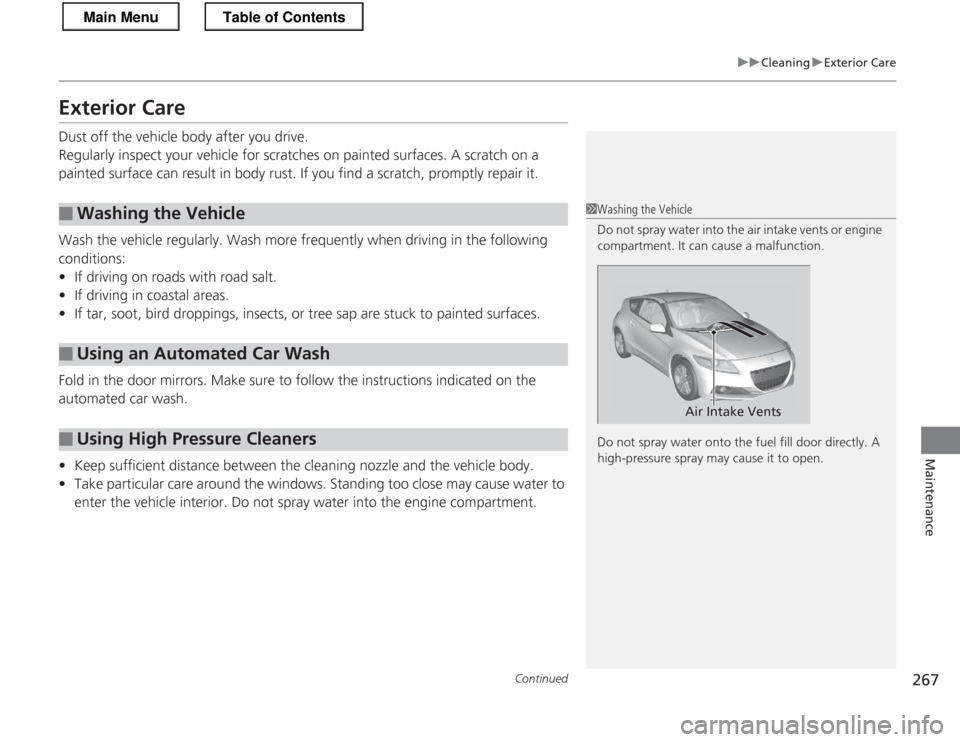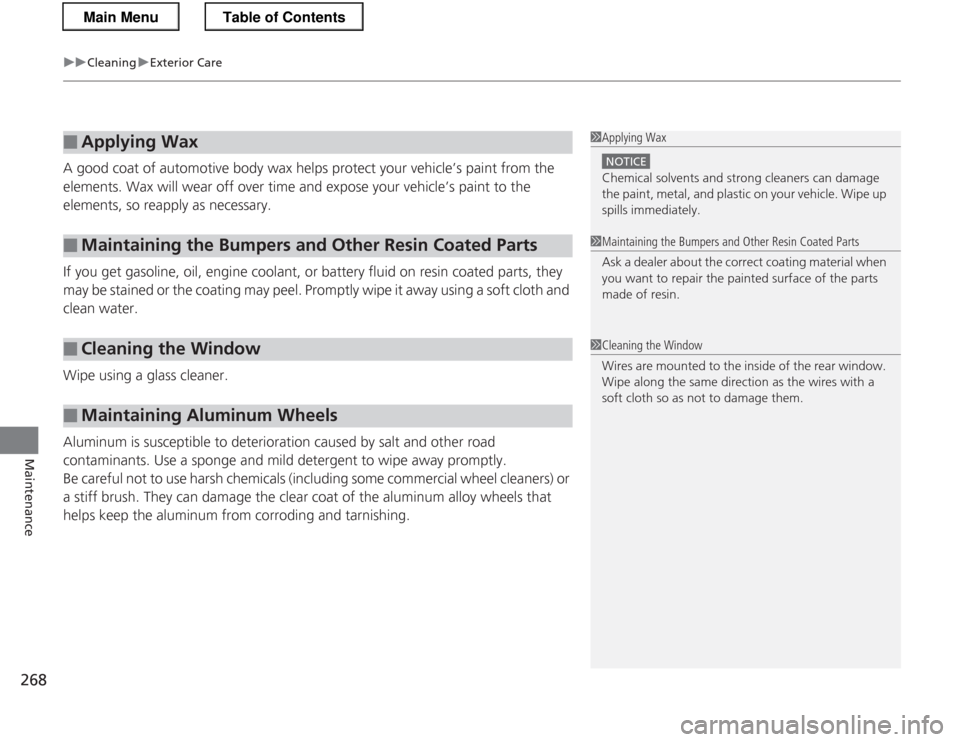Page 238 of 325
237
uuMaintenance Under the HooduEngine Coolant
Maintenance
1. Make sure the engine and radiator are cool.
2. Turn the radiator cap counterclockwise and
relieve any pressure in the cooling system.
Do not push the cap down when turning.
3. Push down and turn the radiator cap
counterclockwise to remove it.
4. The coolant level should be up to the base
of the filler neck. Add coolant if it is low.
5. Put the radiator cap back on, and tighten it fully.
6. Pour coolant into the reserve tank until it reaches the MAX mark. Put the cap back
on the reserve tank.
■Radiator1Radiator
NOTICE
Pour the fluid slowly and carefully so you do not spill
any. Clean up any spills immediately; they can
damage components in the engine compartment.
3WARNING
Removing the radiator cap while the
engine is hot can cause the coolant to spray
out, seriously scalding you.
Always let the engine and radiator cool
down before removing the radiator cap.
Radiator Cap
Main MenuTable of Contents
Page 239 of 325

238
uuMaintenance Under the HooduTransmission Fluid
Maintenance
Transmission Fluid ■Continuously Variable Trans mission (CVT)
Check the fluid level when the engine is at normal operating temperature. 1.Park on level ground, and start the engine.
2. Wait until the radiator fan starts and then
turn off the engine.
uPerform step 3 after waiting for about 60
seconds (less than 90 seconds).
3. Remove the dipstick (yellow loop) from the
transmission and wipe it with a clean cloth.
4. Insert the dipstick all the way back into the
transmission securely, as shown in the image.
5. Remove the dipstick and check the fluid level.
uIt should be between the upper and
lower marks in the HOT range.
6. If the level is below the lower mark, add
fluid into the dipstick hole to bring it to the level between the upper and lower marks,
and have your vehicle checked by a dealer immediately.
■Automatic Transmission Fluid
Specified fluid: Hond a CVTF (continuously variabl e transmission fluid)
1Automatic Transmission Fluid
NOTICE
Do not mix Honda CVTF with other transmission fluids.
Using a transmission fluid other than Honda CVTF
may adversely affect the operation and durability of
your vehicle's transmission, and damage the
transmission.
Any damage caused by using a transmission fluid that
is not equivalent to Honda CVTF is not covered by Honda's new vehicle warranty.
NOTICE
Pour the fluid slowly and carefully so you do not spill
any. Clean up any spills immediately; they can
damage components in the engine compartment.
Upper Mark
Lower Mark
HOT
Range
Main MenuTable of Contents
Page 240 of 325

239
uuMaintenance Under the HooduTransmission Fluid
Maintenance
Check the fluid level when the engine is at normal operating temperature.1.Park the vehicle on level ground.
2. Remove the bolts with a wrench and clips
with a flat-tip screwdriver, then carefully remove the under cover.
3. Remove the transmission filler bolt and
washer.
Carefully feel inside the bolt hole with your
fingers.
uCheck if the fluid level is up to the edge
of the bolt hole.
4. If the fluid level is not up to the edge of the
bolt hole, add Honda Manual Transmission
Fluid (MTF) until it runs out of the hole.
5. Put a new washer on the filler bolt, then
reinstall the filler bolt.
uTightening torque:
33 lbf�ft (44 N�m, 4.5 kgf�m)
6. Reinstall the under cover with the bolts and
clips.
■Manual Transmission Fluid
Specified fluid: Honda Manual Transmission Fluid (MTF)
1Manual Transmission Fluid
If Honda MTF is not available, you may use the API
certificated SAE 0 W-20 or 5 W-20 viscosity motor oil
as a temporary measure.
Replace with MTF as soon as possible. Motor oil does
not contain the proper additives for the transmission
and continued use can cause decreased shifting
performance and lead to transmission damage.
Under CoverBolt Clip
Main MenuTable of Contents
Page 242 of 325
241
uuMaintenance Under the HooduRefilling Window Washer Fluid
Maintenance
Refilling Window Washer Fluid
Check the amount of window washer fluid using the washer fluid level gauge on the cap.If the level is low, fill the washer reservoir.
If the washer fluid is low, a message appears on the multi-information display.
Pour the washer fluid carefully. Do not overflow the reservoir.
Models with washer fluid level gauge1Refilling Window Washer Fluid
NOTICE
Do not use engine antifreeze or a vinegar/water
solution in the washer reservoir.
Antifreeze can damage your vehicle's paint. A
vinegar/water solution can damage the washer pump.
Level Gauge
Models with washer level sensor
Main MenuTable of Contents
Page 268 of 325

267
uuCleaninguExterior Care
Continued
Maintenance
Exterior Care
Dust off the vehicle body after you drive.
Regularly inspect your vehicle for scratches on painted surfaces. A scratch on a
painted surface can result in body rust. If you find a scratch, promptly repair it.
Wash the vehicle regularly. Wash more frequently when driving in the following
conditions: •If driving on roads with road salt.
• If driving in coastal areas.
• If tar, soot, bird droppings, insects, or tree sap are stuck to painted surfaces.
Fold in the door mirrors. Make sure to follow the instructions indicated on the automated car wash. • Keep sufficient distance between the cleaning nozzle and the vehicle body.
• Take particular care around the windows. St anding too close may cause water to
enter the vehicle interior. Do not spray water into the engine compartment.
■Washing the Vehicle
■Using an Automated Car Wash
■Using High Pressure Cleaners
1Washing the Vehicle
Do not spray water into the air intake vents or engine
compartment. It can cause a malfunction.
Do not spray water onto the fuel fill door directly. A
high-pressure spray may cause it to open.
Air Intake Vents
Main MenuTable of Contents
Page 269 of 325

uuCleaninguExterior Care
268
Maintenance
A good coat of automotive body wax helps protect your vehicle’s paint from the
elements. Wax will wear off over time and expose your vehicle’s paint to the
elements, so reapply as necessary.
If you get gasoline, oil, engine coolant, or battery fluid on resin coated parts, they
may be stained or the coating may peel. Promptly wipe it away using a soft cloth and clean water.
Wipe using a glass cleaner.
Aluminum is susceptible to deterio ration caused by salt and other road
contaminants. Use a sponge and mild de tergent to wipe away promptly.
Be careful not to use harsh chemicals (including some commercial wheel cleaners) or
a stiff brush. They can damage the clear coat of the aluminum alloy wheels that
helps keep the aluminum from corroding and tarnishing.
■Applying Wax
■Maintaining the Bumpers and Other Resin Coated Parts
■Cleaning the Window
■Maintaining Aluminum Wheels
1Applying Wax
NOTICE
Chemical solvents and strong cleaners can damage
the paint, metal, and plastic on your vehicle. Wipe up
spills immediately.
1Maintaining the Bumpers and Other Resin Coated Parts
Ask a dealer about the correct coating material when
you want to repair the painted surface of the parts made of resin.
1Cleaning the Window
Wires are mounted to the inside of the rear window.
Wipe along the same direction as the wires with a
soft cloth so as not to damage them.
Main MenuTable of Contents
Page 270 of 325

269
Handling the UnexpectedThis chapter explains how to handle unexpected troubles.
Tools
Types of Tools .................................. 270
If a Tire Goes Flat
Changing a Flat Tire *
....................... 271
Temporarily Repairing a Flat Tire....... 277
Engine Does Not Start
Checking the Engine ........................ 286
Jump Starting .................................... 287
Shift Lever Does Not Move .............. 289
Overheating
How to Handle Overheating ............. 290 Indicator, Coming On/Blinking
If the Low Oil Pressure Indicator Comes On ............................................. 292
If the Charging System Indicator Comes On ................................................. 293
If the Malfunction Indicator Lamp Comes
On or Blinks ................................... 294
If the Brake System Indicator (Red) Comes
On ................................................. 295
If the EPS System Indicator Comes On.. 295
If the IMA Indicator Comes On......... 296 If the Low Tire Pressure/TPMS Indicator
Comes On or Blinks ....................... 296
Fuses
Fuse Locations ................................. 297
Inspecting and Changing Fuses ........ 300
Emergency Towing ........................... 301
When You Cannot Open the Hatch ..... 303
* Not available on all models
Main Menu
Page 275 of 325

uuIf a Tire Goes FlatuChanging a Flat Tire*
274
Handling the Unexpected
1. Place the jack under the jacking point
closest to the tire to be changed.
2. Turn the end bracket (as shown in the
image) clockwise until the top of the jack
contacts the jacking point.
uMake sure that the jacking point tab is
resting in the jack notch.
3. Raise the vehicle, using the jack handle bar
and the jack handle, until the tire is off the
ground.
■How to Set Up the Jack1How to Set Up the Jack
Do not use the jack with people or luggage in the
vehicle.
Use the jack provided in your vehicle.
Other jacks may not support the weight (“load”) or their shape may not match.
The following instructions must be followed to use the jack safely.
• Do not use while the engine is running.
• Use only where the ground is firm and level.
• Use only at the jacking points.
• Do not get in the vehicle while using the jack.
• Do not put anything on top of or underneath the
jack.
3WARNING
The vehicle can easily roll off the jack,
seriously injuring anyone underneath.
Follow the directions for changing a tire
exactly, and never get under the vehicle
when it is supported only by the jack.
Jack Handle BarWheel Nut
Wrench as Jack Handle
Main MenuTable of Contents